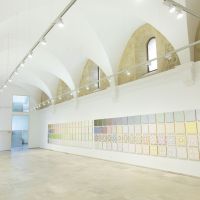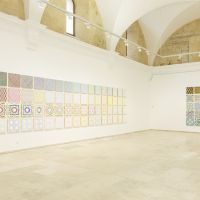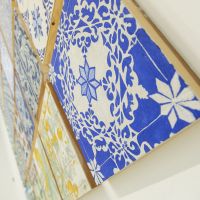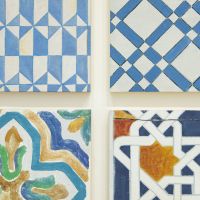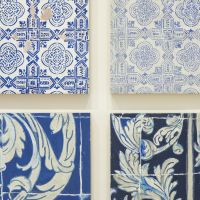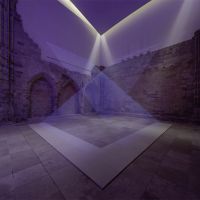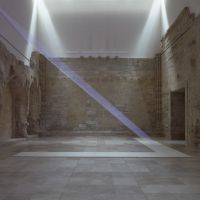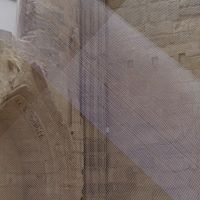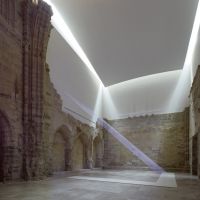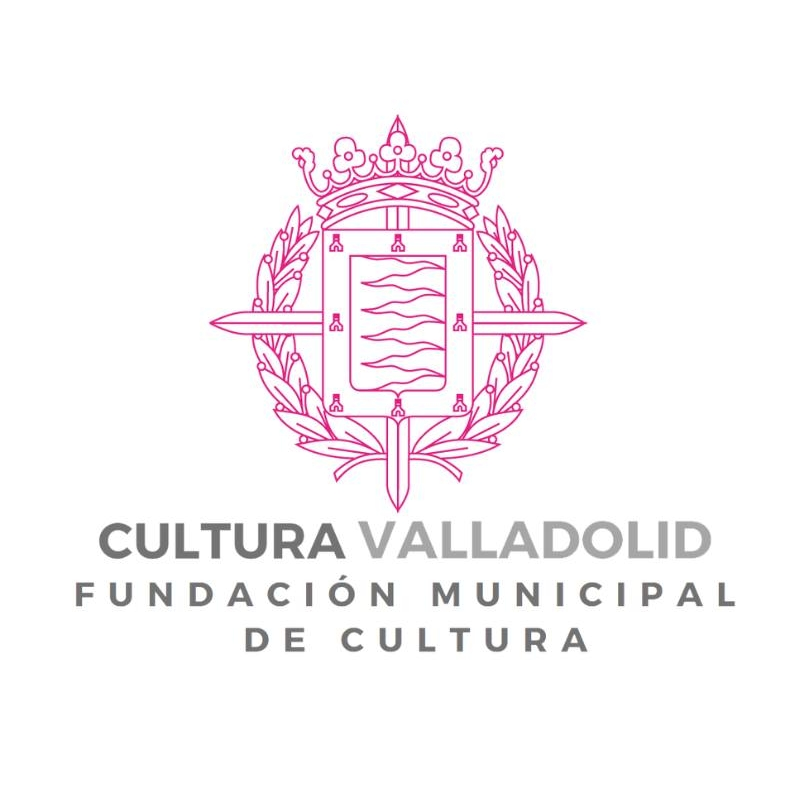SOLEDAD SEVILLA
De la luz del sol y de la luna

[English version below]
El proyecto De la luz del sol y de la luna, que ocupa la Capilla de los Condes de FuensaldaÃąa, ofrece con ejemplar nitidez las claves del trabajo de una artista, Soledad Sevilla, que ha forjado su carrera en el desarrollo infatigable de unas inquietudes estÃĐticas que permanecen en su libreto desde sus inicios. Toda su obra se caracteriza por la fidelidad a un ideal que se ha ido enriqueciendo y revigorizando con precisiÃģn y frescura. No en vano, Soledad Sevilla no ha dejado de ser relevante en ningÚn tramo de una carrera de mÃĄs de medio siglo.
Este ideal es el del anÃĄlisis de la lÃnea sobre el plano, que somete a un sistema de permutaciones y combinaciones, de reiteraciones y quiebros, de pliegues, arritmias y giros que articulan espacios dinÃĄmicos de densidad variable. Desde muy pronto, Soledad Sevilla quiso subrayar que el carÃĄcter analÃtico de su obra no eludÃa la bÚsqueda de un universo poÃĐtico ââun mundo emocional, incluso de presagiosâ-, dijo en su dÃa. Ante la bellÃsima expectativa del âpresagioâ, reconocemos su inscripciÃģn en la vertiente lÃrica de la tradiciÃģn conceptual, aquella por la que ciertos artistas se consideraban mÃĄs âmÃsticos que racionalesâ y cuyas obras âllegaban a conclusiones que la lÃģgica era incapaz de alcanzarâ, como apuntÃģ el artista estadounidense Sol LeWitt. Y asÃ, entre el fragor con el que se entrama la lÃnea y la intuiciÃģn del espacio poÃĐtico, viene desarrollÃĄndose una obra que se encuentra entre las mÃĄs destacadas no sÃģlo en el ÃĄmbito de la geometrÃa sino en el conjunto de la producciÃģn abstracta en EspaÃąa. Soledad Sevilla recibiÃģ el Premio VelÃĄzquez 2020 el pasado mes de noviembre. Ãsta que ahora le dedica el Museo Patio Herreriano es la primera muestra desde aquel galardÃģn.Â
Soledad Sevilla ha llevado a menudo esta reflexiÃģn en torno a la lÃnea y el plano un paso mÃĄs allÃĄ al situarla en el marco de la arquitectura, algo que empezÃģ a desarrollar desde los aÃąos ochenta en edificios histÃģricos o en otros mÃĄs neutros. En esa lÃnea se inserta âDe la luz del sol y de la lunaâ, un trabajo realizado con hilos de algodÃģn que se distribuyen en dos grandes planos entrecruzados ocupando la Capilla de los Condes de FuensaldaÃąa. El ritmo riguroso y preciso de los hilos entra en contacto con la arquitectura y, a la vez, con la luz que se desliza desde el exterior, variable en funciÃģn del momento del dÃa. Es ahà donde reside la singularidad de esta pieza, en la lÃnea al vuelo que se inscribe en la ruina certera del espacio, certera pues en ella reside la equilibrada ambivalencia entre pasado y presente que caracteriza su arquitectura y a la que se suma el brillo cambiante de la luz. Soledad Sevilla satisface en este espacio ese anhelo ancestral de tantos artistas que han querido representar la luz con la mayor precisiÃģn posible. Es mÃĄs: en funciÃģn del movimiento del sol sobre nuestra capilla, parecerÃa que, mÃĄs que representaciÃģn, su obra se revela como luz en sà misma.
The project entitled âOn Sunlight and Moonlightâ, which we are now presenting in the Chapel of the Counts of FuensaldaÃąa provides us very clearly with the keys to the work of an artist, Soledad Sevilla, who has forged her career in the untiring development of aesthetic concerns that have remained in her libretto right from the beginning of her career. All her work is characterised by a loyalty to an ideal that has always been enriched and reinvigorated with precision and freshness. It is not in vain that Soledad Sevilla has never ceased to be relevant at any stage of a career that now spans more than half a century.
This ideal is the analysis of the line on the plane, as subjected to a system of permutations and combinations, of reiterations and breaks, folds, arrhythmias and turns that articulate dynamic spaces of variable density. From very early on, Soledad Sevilla wished to emphasise that the analytical nature of her work did not elude the search for a poetic universe â âan emotional world, even one of omensâ, as she once said. In view of the beautiful expectation of the âomenâ, we acknowledge its inclusion in the lyrical aspect of the conceptual tradition, under which certain artists were considered âmore mystical than rationalâ and whose work âreached conclusions that logic was unable to reachâ, as the American artist Sol LeWitt pointed out. And so, amidst the din with which the line and intuition of poetic space are woven, a body of work has been produced that is among the most outstanding not only in the field of geometry but in the whole of abstract production in Spain. Soledad Sevilla was awarded the VelÃĄzquez Prize for 2020 last November. This exhibition, now devoted to her by the Patio Herreriano Museum, is the first to be held since the award.Â
Soledad Sevilla has taken her reflection upon line and plane one step further when she has addressed architecture as a medium in a group of works developed in historical spaces or more neutral ones. In this vein we find âOf Sunlight and Moonlightâ, a work specifically created for the Chapel of the Counts of FuensaldaÃąa. The rigorous rhythm of the fine cotton threads comes into contact with the architectural language, and at the same time, as the light falls, varying greatly depending on the time of day. This is where the uniqueness of this piece lies, in the arrangement of the line in flight in the unerring ruin of space, unerring in that it brings together a balanced ambivalence between past and present, which is the main characteristic of this architecture, and where the changing brightness of light takes hold. Soledad Sevilla fulfills the old wish of so many artists trying to grasp the light with as much precision as possible. And not only that: at certain stages depending on the position of the sun above the chapel, rather than a representation of light, the work is light in itself.Â

